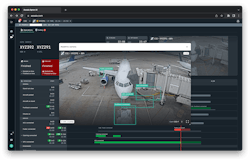Fraport Slovenija Reduces Ground Delays with TurnaroundControl
On-time performance (OTP) is an important metric for ground service providers. Ensuring aircraft are serviced efficiently is key to effective turnarounds.
At Ljubljana Jože Pučnik Airport (LJU), for example, average ground delays have been reduced by nearly six minutes since airport operator Fraport Slovenija started using Assaia’s turnaround technology.
Dubbed TurnaroundControl, Assaia’s solution uses a combination of computer vision and artificial intelligence (AI) to monitor every aspect of the turnaround. The resulting data is integrated into the airport, airline and ground handling systems, providing real-time information through a dashboard that includes tailored alerts.
Throughout a two-month period, Fraport Slovenija realized a nearly six-minute reduction in average ground delays for flights where alerts were acknowledged compared to those where alerts were not acknowledged.
At LJU, the largest airport in Slovenia, TurnaroundControl is deployed at all critical gates.
“Our focus is to use innovation to make our operations smoother,” said Dr. Babett Stapel, managing director of Fraport Slovenjia.
In addition to TurnaroundControl facilitating communication between the ground crew and cockpit, Oliver Weiss, chief operating officer, Faport Slovenija, says the organization will be able to organize its ground crew exactly to actual timing, rather than the planned times.
“We will see in advance if there is some delay, and we will be able to consider the load factors, how many pieces of baggage are there, how much crew is required, and be much more flexible in terms of turnaround management,” Weiss says
Jans Willem Kappes, SVP global sales, Assia, adds the solution will also help improve the planning and the standard operating procedures of each turnaround.
While the key focus of TurnaroundControl is on-time performance, Christiaan Hen, CEO of Assaia, says safety and sustainability are also important.
“Alerts can show when a safety protocol is being breached,” Hen points out. “And we can track when auxiliary power units (APUs) are turned off: keeping them on longer than planned can have a significant impact on carbon emissions.”
Fraport Slovenjia selected Assaia TurnaroundControl for several reasons.
“It is also really important for us that it has a good record of successful implementation, so we know it will deliver for us, for our airlines and ultimately for our passengers,” Stapel says.
Together with Assaia, Fraport is looking at the turnaround process in order to shorten the time the aircraft is on the ground. According to Claus Grunow, VP corporate strategy and digitalization, Fraport, this will be a benefit for both passengers and Fraport’s airline partners.
“This technical solution is not bound to one airport so we will talk to all airports in our group because it is a common challenge we are facing,” he adds.
According to Grunow, the solution was found during Fraport’s Open Pitch Day, an opportunity for startups and other companies to present their technologies to Fraport AG’s Digital Factory.
“We just look into our ecosystem and take in groundbreaking new ideas and try to bring them into our ecosystem and maybe even at all our airports in the end,” he describes.
About the Author
Rebecca Kanable
Assistant Editor
Rebecca Kanable, a veteran journalist, worked with Endeavor Business Media's aviation group from 2021 to 2024 as assistant editor of Airport Business, AMT and Ground Support Worldwide. She previously worked for various publications, including trade magazines and newspapers.

